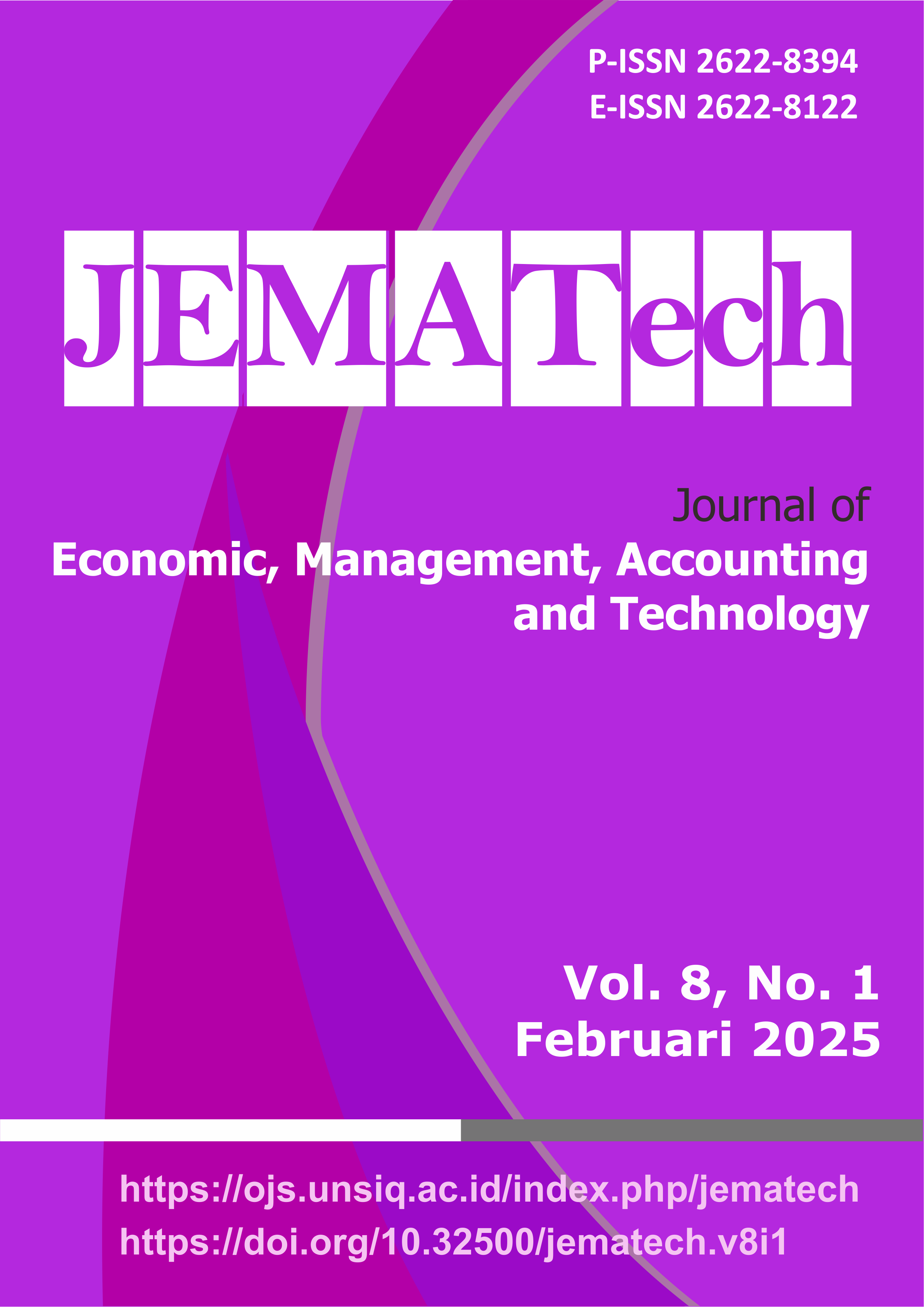Gamifikasi Pada Aplikasi E-Commerce Terhadap Minat Beli Konsumen
DOI:
https://doi.org/10.32500/jematech.v8i1.8801Keywords:
gamifikasi, keterlibatan merek, hiburan perceived enjoyment dan niat membeli.Abstract
Persaingan dalam industri e-commerce di Indonesia semakin ketat, terbukti dengan munculnya banyak perusahaan e-commerce baru. Setiap perusahaan berlomba-lomba merancang strategi pemasaran untuk menarik minat konsumen agar menggunakan aplikasi e-commerce mereka. Penelitian pada artikel ini ditujukan untuk menganalisa pengaruh gamifikasi, perceived enjoyment, dan entertainment terhadap brand engagement serta niat beli konsumen di e-commerce. Pada penelitian yang telah dilakukan sebelumnya memanfaatkan pendekatan secara kuantitatif, dengan data yang diperoleh menggunakan pertanyaan melalui media Google Form yang diisi oleh 295 responden. Responden dipilih dengan memanfaatkan teknik purposive sampling yang terbagi dalam beberapa persyaratan tertentu, seperti pernah menggunakan fitur gamifikasi dan melihat konten pemasaran dalam aplikasi e-commerce. Hasil penelitian menunjukkan bahwa gamifikasi dan entertainment memiliki pengaruh terhadap brand engagement, sementara perceived enjoyment tidak berpengaruh. Selain itu, brand engagement terbukti memengaruhi niat beli konsumen di e-commerce. Temuan penelitian ini diharapkan dapat membantu perusahaan e-commerce dalam merancang strategi pemasaran yang lebih tepat dan efektif.
References
Aji, P. M., Nadhila, V., & Sanny, L. (2020). Effect of social media marketing on instagram towards purchase intention: Evidence from Indonesia’s ready-to-drink tea industry. International Journal of Data and Network Science, 4(2), 91–104. https://doi.org/10.5267/J.IJDNS.2020.3.002
Bilal, M., Jianqu, Z., & Ming, J. (2021). How Consumer Brand Engagement Effect on Purchase Intention? The Role of Social Media Elements. Journal of Business Strategy Finance and Management, 2(1–2), 44–55. https://doi.org/10.12944/JBSFM.02.01-02.06
Chandra, J., & Briliana, V. (2021). Mobile Apps Usefulness, Perceived Enjoyment, Trust dan Perceived Benefit terhadap Intention to Purchase Decisions Indonesian Street Food di Jakarta. Jurnal Bisnis Dan Akuntansi, 23(2), 267–280. https://doi.org/10.34208/JBA.V23I2.1074
Condrobimo, A, R. & Sandra, D. Implementasi Gamifikasi dalam Pemasaran Digital untuk E-Commerce. Diakses dari: https://sis.binus.ac.id/2023/05/22/implementasi-gamifikasi-dalam-pemasaran-digital-untuk-e-commerce/
De Canio, F., Fuentes-Blasco, M., & Martinelli, E. (2021). Engaging shoppers through mobile apps: the role of gamification. Vinet, L., Zhedanov, A. (2011). A “missing” fami. https://doi.org/10.1108/IJRDM-09-2020-0360
Hair, J. F., Risher, J. J., Sarstedt, M., & Ringle, C. M. (2019). When to use and how to report the results of PLS-SEM. European Business Review, 31(1), 2–24. https://doi.org/10.1108/EBR-11-2018-0203/FULL/XML
Huotari, K., & Hamari, J. (2017). A definition for gamification: anchoring gamification in the service marketing literature. https://doi.org/10.1007/s12525-015-0212-z
Jansen. (2019). Pengaruh Service Attributes Terhadap Overall Satisfaction Dan Membership Renewal Intention Member Knockout Boxing Camp Surabaya.
Laato, S., Islam, A. K. M. N., Farooq, A., & Dhir, A. (2020). Unusual purchasing behavior during the early stages of the COVID-19 pandemic: The stimulus-organism-response approach. Journal of Retailing and Consumer Services, 57, 102224. https://doi.org/10.1016/J.JRETCONSER.2020.102224
Lim, W. M., & Rasul, T. (2022). Customer engagement and social media: Revisiting the past to inform the future. Journal of Business Research, 148, 325–342. https://doi.org/10.1016/J.JBUSRES.2022.04.068
Manalu, M., & Kurniawan, F. (2021). Atraksi Entertainmentdalam Komunikasi Pemasaran Produk Wisata (Studi: Kebun Raya Baturraden). Jurnal Administrasi Bisnis Terapan (JABT), 4(1), 5. https://doi.org/10.7454/jabt.v4i1.1022
Martins, J., Costa, C., Oliveira, T., Gonçalves, R., & Branco, F. (2019). How smartphone advertising influences consumers’ purchase intention. Journal of Business Research, 94, 378–387. https://doi.org/10.1016/J.JBUSRES.2017.12.047
Muhson, A. (2022). Analisis Statistik dengan SmartPLS ii Analisis Statistik dengan SmartPLS: Path Analysis, Confirmatory Factor Analysis, & Structural Equation Modeling.
Nugraha, W. A. Gunawan, T & Istiharini. 2024. Menjelajahi Peran Gamifikasi Dalam Loyalty Program Di Indonesia. YUME : Journal of Management
Nur Arafah, N., Kamilatunaimah, M., Huang, C., Fahlevi, R., Internasional Batam, U., & Gajah Mada Baloi Sei Ladi, J. (2022). Strategi Digital Marketing Menggunakan Media Sosial Dan E-Commerce Dalam Pengembangan Bisnis Umkm Yasmin’s Brownies. MANABIS: Jurnal Manajemen Dan Bisnis, 1(4), 259–271. https://doi.org/10.54259/MANABIS.V1I4.1379
Pedreira, O., García, F., Brisaboa, N., & Piattini, M. (2015). Gamification in software engineering - A systematic mapping. Information and Software Technology, 57(1), 157–168. https://doi.org/10.1016/J.INFSOF.2014.08.007
Purwianti, L., Nurjanah, L., Katherine, K., & Chen, R. (2024). The Impact of TAM, Social Influence, and Information Quality on Purchase Intention in E-commerce. Jurnal Organisasi Dan Manajemen, 20(2), 187–206. https://doi.org/10.33830/JOM.V20I2.9123.2024
Riskos, K., Hatzithomas, L., Dekoulou, P., & Tsourvakas, G. (2022). The influence of entertainment, utility and pass time on consumer brand engagement for news media brands: a mediation model. Journal of Media Business Studies, 19(1), 1–28. https://doi.org/10.1080/16522354.2021.1887439
Rosalinda, R., & Sinambela, F. A. (2023). Pengaruh Dimensi Online Service Quality Terhadap Online Loyalty Melalui Mediasi Online Satisfaction Pada Pengguna E-commerce C2C di Kota Batam. At-Tadbir : Jurnal Ilmiah Manajemen, 7(1), 1–22. https://doi.org/10.31602/ATD.V7I1.9143
Santos-Vijande, M. L., Gómez-Rico, M., Molina-Collado, A., & Davison, R. M. (2022). Building user engagement to mhealth apps from a learning perspective: Relationships among functional, emotional and social drivers of user value. Journal of Retailing and Consumer Services, 66, 102956. https://doi.org/10.1016/J.JRETCONSER.2022.102956
Sun, Y., & Gao, F. (2020). An investigation of the influence of intrinsic motivation on students’ intention to use mobile devices in language learning. Educational Technology Research and Development, 68(3), 1181–1198. https://doi.org/10.1007/S11423-019-09733-9/METRICS
Vjollca Visoka Hasani, Jusuf Zeqiri, Teodora Todorovik, Dhouha Jaziri, & Asdren Toska. (2024). Digital Content Marketing and EWOM: A Mediational Serial... Sciendo, 24–43. https://sciendo.com/article/10.2478/bsrj-2023-0010
Vo Minh, S., Nguyen Huong, G., & Dang Nguyen Ha, G. (2022). The role of social brand engagement on brand equity and purchase intention for fashion brands. Cogent Business & Management, 9(1). https://doi.org/10.1080/23311975.2022.2143308
Wulandari, N. A., Saidani, B., & P, A. K. R. (2022). Pengaruh Gamification dalam Membentuk Brand Loyalty melalui Brand Engagement. Jurnal Bisnis, Manajemen, Dan Keuangan, 3(1), 228–236. https://doi.org/10.21009/JBMK.0301.17
Zeqiri, J. Koku, P, S. Dobre, C. Maria Milovan, A. & Paientko, T. 2024. The Impact of Social Media Marketing On Brand Awareness, Brand Engagement, and Purchase Intention in Emerging Economies. Marketing Intellegence and Planning.Emerald Publishing Limited.


